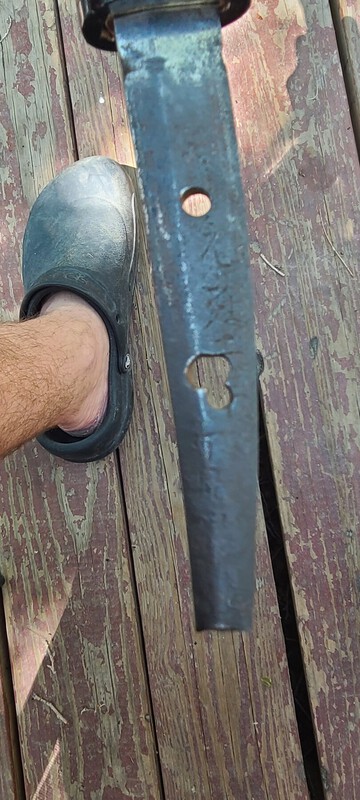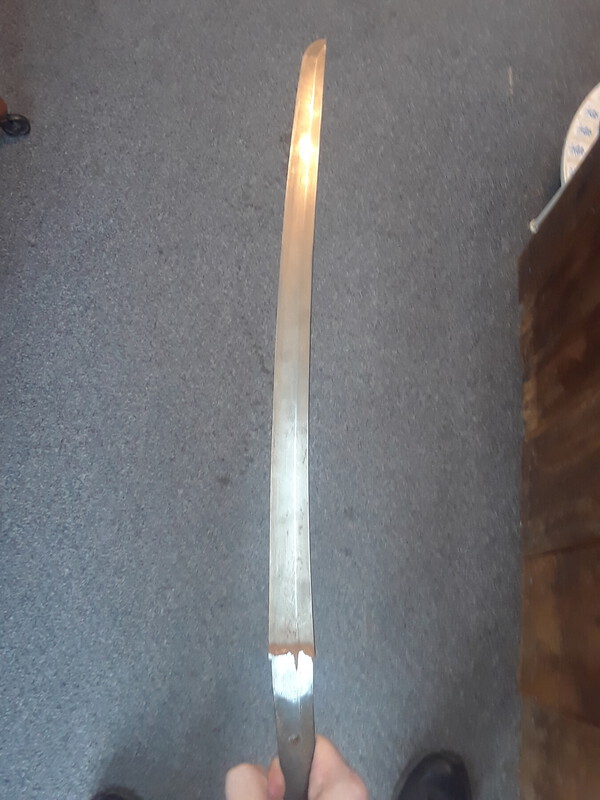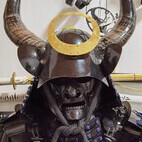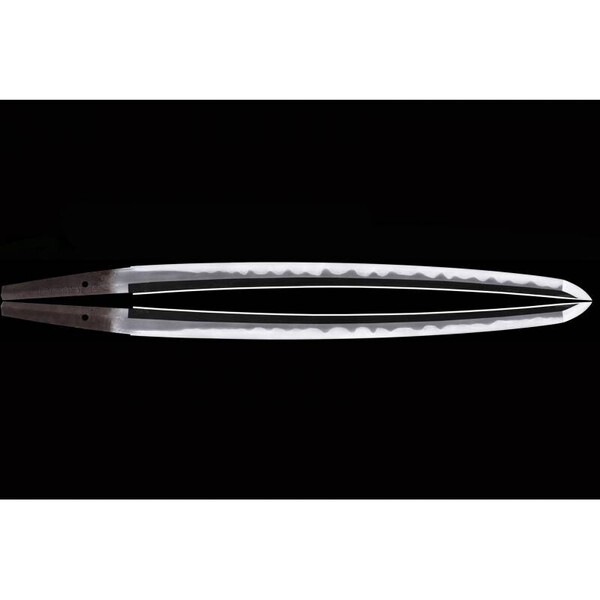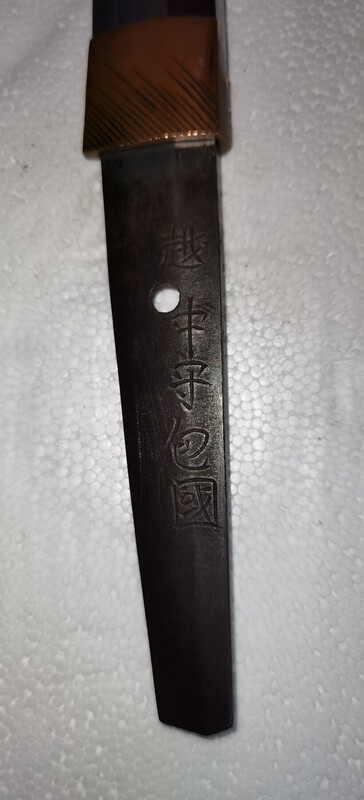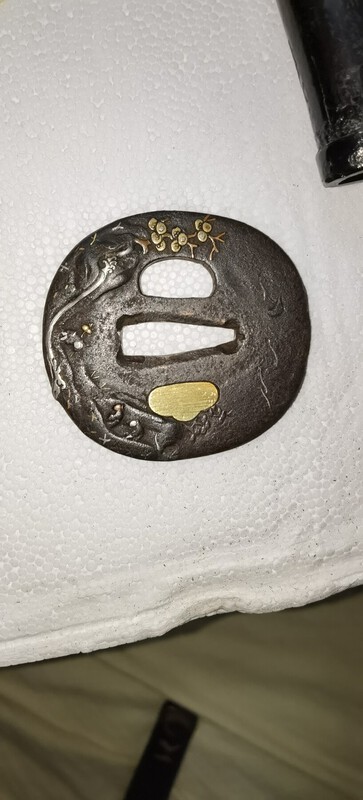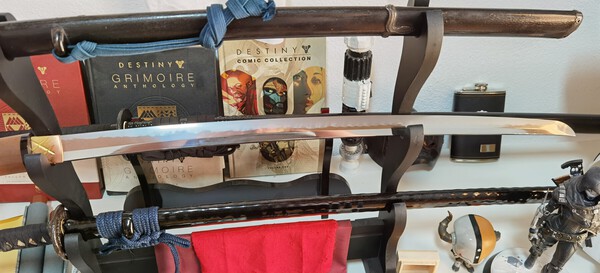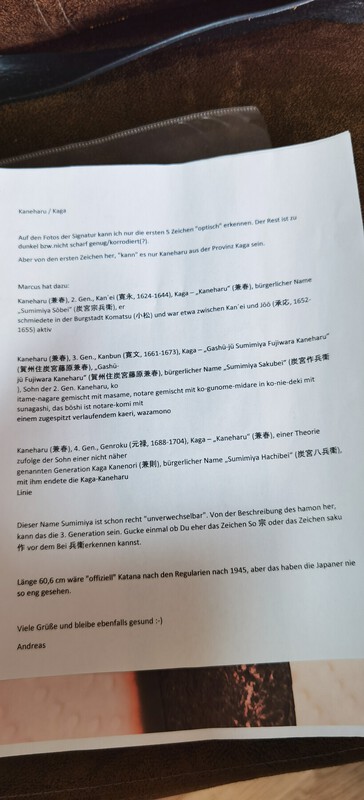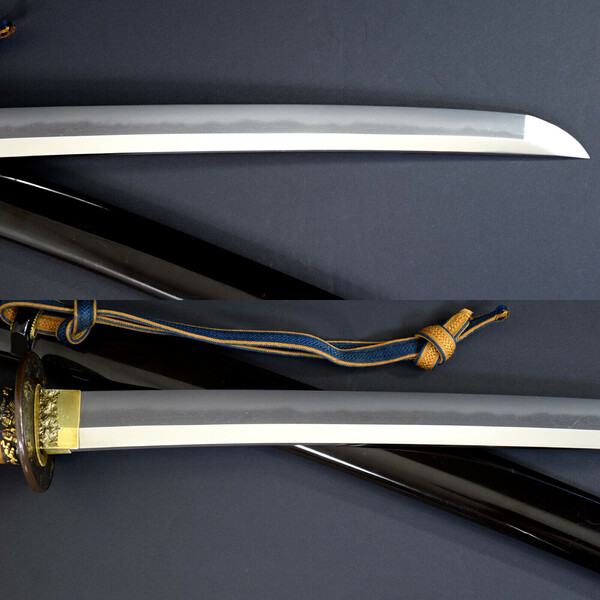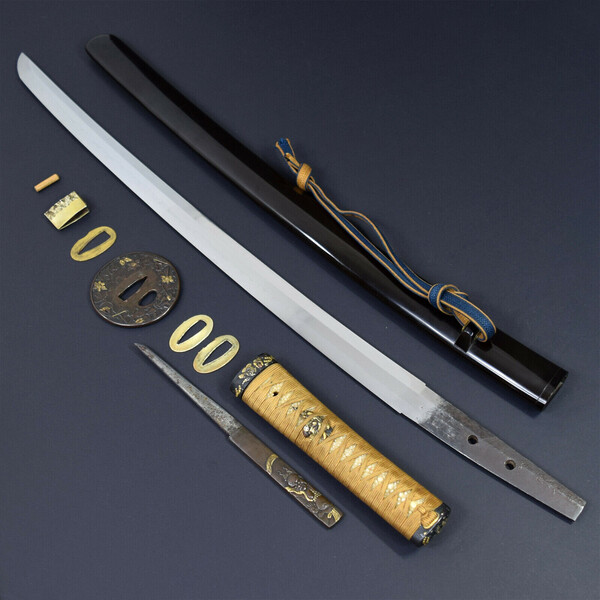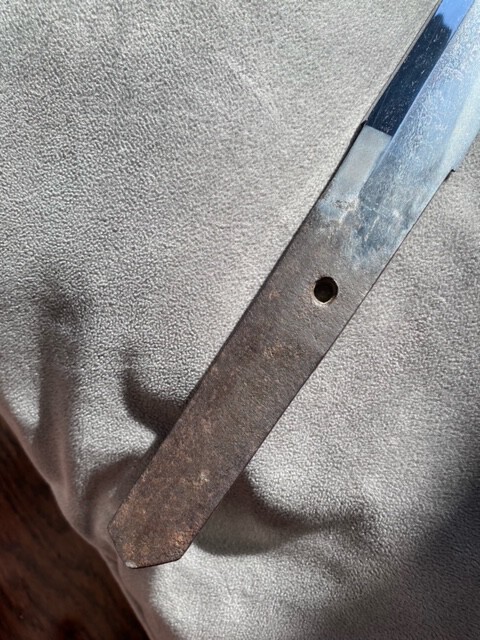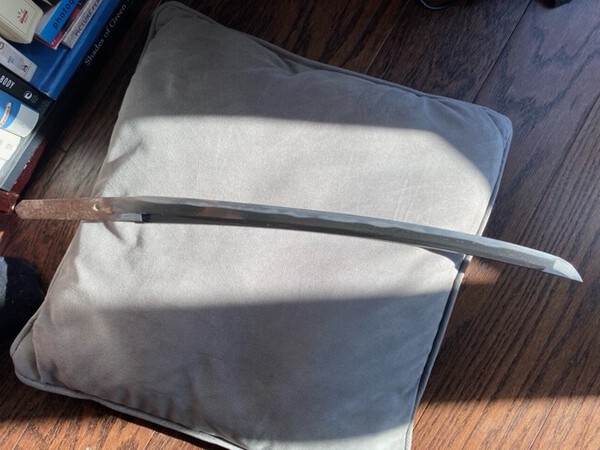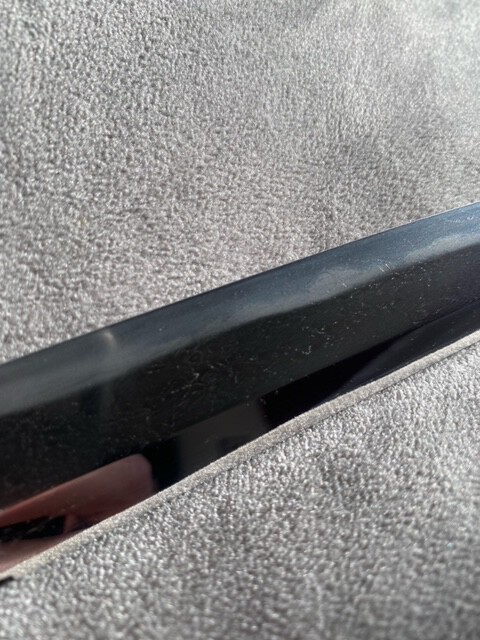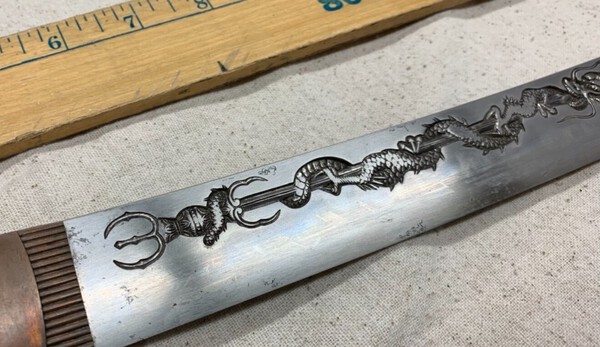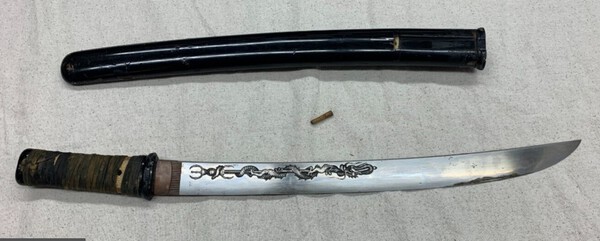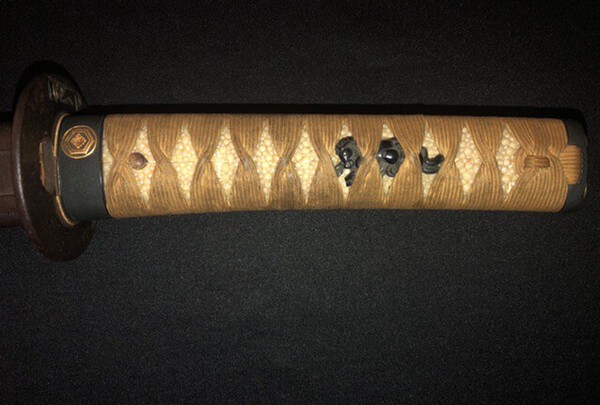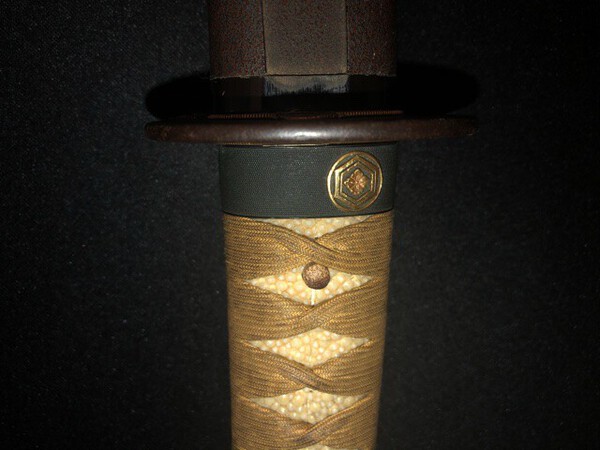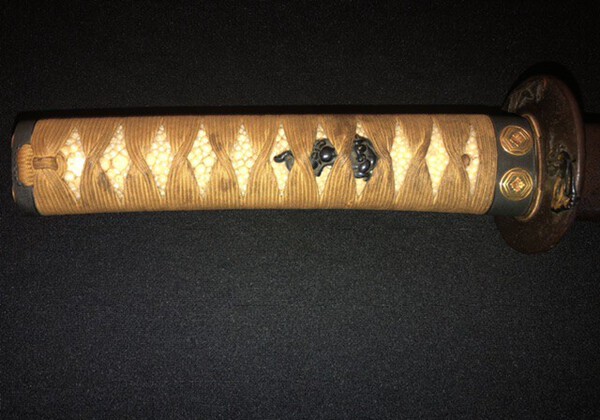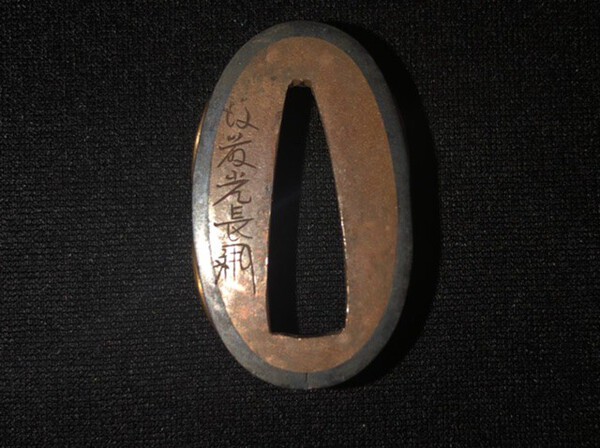Search the Community
Showing results for tags 'wakizashi'.
-
An Edo Period Wakizashi made by Third-gen Izumi no Kami Rai Kinmichi和泉守来金道 with Shirasaya The third-gen Izumi no Kami Rai Kinmichi was forging blades in Kyoto in the early Edo period(Mid-Late 17 century).He was allowed to inscribe a chrysanthemum emblem, which is the symbol of the Japanese emperor. His sword-forging technique was so great that the emperor licensed him to use this emblem, which was quite honorable for any swordsmiths. Blade length: 54cm Sori : 0.9cm Weight: 514g SOLD Reasonable offers accepted, please PM if interested.
-
I came across this on Ebay-Netherlands and thought it might be worth posting. A small engraving on the nakago. The following is copied from the items description...... "The image/symbol on the tang is ENGRAVED and NOT stamped into the metal. I am told that the figure engraved into the Tang is one of the seven gods of Japan. I am told it is the "Happy Buddah" and I've also been told it is of the god "Daikoku", or "Daikokuten", one of the seven Gods of good luck/fortune-for agriculture, farmers, and wealth. I have shown this blade to several acknowledged "experts"-all of whom want the blade but none of whom would/could tell me "specifics." " Never seen anything like that myself and thought it may be better under this thread than a new one....but relocate if you wish. For interest @Bruce Pennington Rob
-
Having just seen a post about current shipping problems I am very aware of having just got this in time, (arrived yesterday)... and i no longer begrudge the shipping fee, which was more than the cost of the ensemble. I use the word advisedly because I have no idea if this package started life together or if it's just a collection of parts, assembled by the dealer. At the price paid, which was less than I would expect for any single item, saya, tsuka or tsuba I have no gripes or issues, though I would have liked the junk tsunagi to have arrived in one piece. Vendors photo's for the most part.
-
I recently came across this eBay listing for a Wakizashi with a Rai school mei that the seller claims to be Rai Kuniyuki. I am not even a beginner at Kantei so would like to seek feedback from you all. Looking at the pictures, it seems clear to me that the Mei is not that of Kuniyuki 来國行 or any of the well-known Rai school smiths I can find. The second kanji may be mitsu 光, and the third kanji maybe kuni 國 (yet it doesn't match the signature styles of the Rai smiths for this character). The first two characters also appear very new if this is indeed a Koto. Other than that, the wide Suguha hamon and its extension pass the hamachi does indicate this is a suriage blade cut down by a lot, and perhaps the hamon does generally fit the Rai school style? It seems to me that the hamon is too straight/regular for this period though. Overall the blade is out of polish but not in bad condition I think, I would think this is a fake but again I am not experienced. Thought it would be a nice academic exercise to learn more about blades like this. The seller does have a negative feedback for refusing to deliver a sold sword in another eBay auction. Here's the link, with more pictures and measurements: https://www.ebay.com/itm/224705458005
-
Dear NMB members: I am having a bit of difficulty with this mei and translation. Hopefully someone can help. It just came into my office yesterday from an 83 year old gentleman. I am wondering if it is "Something (no) Kami Norinao," or maybe "Tsuda Omi (no) Kami Sukenao." I cannot tell if the date is 1521 +3, or if the date side has a special made for name or invocation, or what. If you think it could be by this "Sukenao," does anyone have a legit mei by this smith for comparison? It came in shirasaya with horn parts on the mekugi peg and the koiguchi. The blade is kind of slender, with two-piece silver habaki. Any help is appreciated. Regards, Bill E. Sheehan (Yoshimichi)
-
The sun-nobi tanto I just received arrived without a shirasaya. It does have a fairly nice koshirae. When I asked about having a shirasaya made while the blade was still in Japan, the vendor stated it already had one, but alas, it arrived dressed in its koshirae. So now I have a blade in need of a shirasaya, and I live in Canada. What is my best option for having one made? Thanks for any input you can provide.
-
I just got notified that my second Nihonto in in transit from Japan. It will hopefully be here by Thursday. It is another sunnobi tanto. Photos from Aoi Art are attached. When I have it in hand I will post some more pictures. This blade passed Hozon in June.
-
Finally some good news from Japan! The two blades (a Katana and a Wakizashi/Sun Nobi Tanto) that I had in for Shinsa since June have both passed for Hozon. I have to get some restoration work done on the koshirae of one of them, and also have to get a shirasaya made as it does not have one. So it will probably be a few more months before I actually have them in hand. I don't have a full report on the details of the Shinsa. I only know that they have passed at this time. I suppose that it will take another month or two before the Origami are actually produced. I have never gone through this process before, and really had no idea how long things take to happen. I will be curious to see the results for the Katana especially as it had two sets of older kicho papers. It was judged as Fujishima the first time and judged as Shitahara the second time.
-
Hello all. Brand new here so if asking these questions break any community rules, I apologize. Recently my father came across a couple swords in antique store. To his untrained eye, they looked legit. I believe they are as well. We are looking for some more input and opinions. Here are the blades with multiple angles. First is the wakizashi and a kogatana (which was pointed out to me that it could be gimei and I'm not too worried about it). I can't upload all of the pictures but I will include links to imgur with albums of both pieces. If interested, the mei is in the album and we believe it says Jumyō. Here is the katana, which we (with some reddit help) deciphered came from Taikei Naotane in 1857. Here are the links for both albums. https://imgur.com/a/UaPLYTI https://imgur.com/a/4V7qNWd These were sold as a set, and the tsuka on each looks similar which I would assume means that they have been a set for some time. If this makes sense, let me know. Thanks in advance for looking, and any input is welcomed as far as what should be our next steps moving forward if these pieces might be worth getting refurbished professionally and possibly papered. R F
- 36 replies
-
- translation
- katana
-
(and 1 more)
Tagged with:
-
Hello, I'm making some room in the collection so I thought I would offer this up for grabs. It comes with the sword registration from Japan. Saya is signed Ikkanshi Tadatsuna Saku. Very nice crystallization shown in the hamon. There are a few very small forge marks but other than that the cutting edge is amazing and the tip is still needle point sharp. Please DM for more pics for serious inquires only. Nagasa: 50.3 cm. Sori: 1.1 cm. Moto-haba: 3.0 cm. Saki-haba: 2.4 cm. Moto-gasane: 0.6 cm. Saki-gasane: 0.5 cm. $2500 US shipped with tracking additional shipping if you live outside the US or Canada.
-
Ok so I have this nice Wak (suguha/combat cover) that I have tried to translate between my best friend (Mrs), the Olympics and Slough's Oshigata = 4 hours, which incidentally is nothing to this retired person....but, I have given up with no conclusive result. It appears to have a Sho stamp (but the inside dosn't look quite right???) therefore made for/during WW2 which I believe from a very reliable source, is rare for a Wak. I might start a thread on that matter as soon as I get this sorted. For my first real attempt, and I am sure a chuckle for a few members I have come up with...... No Shu Izo or Roku or Ama ????? Nin or Hachi Kane Mitsu Saku Kore So I clearly have something wrong in there 😂 ..... need some help...but feel its Kanemitsu but can't recognise that in Slough's. Thankyou in advance. Rob PS...as mentioned, I also went through the Arsenal Stamps thread and have trouble matching the exact stamp on my Wak ??
-
Hi. I want to buy an original sword. the dealer wants to sell me this sword, is it the original? I will be grateful for your messages
-
Good evening, I am looking for some overall help regarding this sword. Any pointers overall including terminology will be appreciated. I posted the sword to a Nihonto discussion group on Facebook a while back and was told the signature was: sagami kuni junin hiromitsu Researching that name I have been able to find two smiths who use that signature, one from the 1300s and one from the 1500s. When I originally posted the pictures I had taken did not reveal any detail about the other side of the nagato. I believe this to have the date the sword was made. Translation of this side would be greatly appreciated as this would go a long way towards telling who the smith is. Also conformation of the original signature translation. Also opinions on authenticity or which smith or time period it is. Thank you More pics on Google share drive: https://photos.app.goo.gl/sjeZ8WWs1efEV7Za9
-
Hey guys, I've got a wakizashi of a friend here. He is curious about whether or not it makes sense to have restored. I told him it largely depends on the signature. The signature looks confidently written, but that could mean nothing. The blade has a clipped/snapped tip, but it appears to not pass through the hardened edge (a few mm of tip loss). The blade is about 18" (from what I remember, I'll change this once he gets back to me) and appears to have a suguha type hamon. It has a shirasaya with integral wooden habaki in poor condition but appears to have once been of good quality. The blade is quite stout and appears healthy enough to receive a polish. It gave me the impression of a Sukesada-type work. My asks for my friend's blade are: Translation of mei Veracity of mei: shoshin or gimei? Worth restoration or no? General impression/opinion Again, any help/feedback is appreciated guys, Thanks! ~Chris
- 11 replies
-
- wakizashi
- restoration
-
(and 1 more)
Tagged with:
-
Hello there, i joined this forum a couple off days ago because i needed help with a sword i got. I have been infected with the nihonto collecting fever a few months ago when i made my first purchase which i want to show off and hear opinions about it now. This wakizashi came with a hozon paper and a full oshigata. i think it was a bit more expensive than it had to be but i got a big discount on the next nihonto i bought from that seller so its alright i guess. it is attributed to "Ecchu Kami Kanekuni (2nd Generation)" of the "Yamato Tengai Kanenaga den" and dated to the Enkyō era (1744-1748). the tsuba does have a signature too but i havent deciphered it yet. if anybody can read it, the info would be greatly appreciated.
-
Posted across several threads due to size limits....please see my profile for the rest.... As promised I'm sharing an overview of our small collection of nihonto. We're a small volunteer run museum in NZ. We don't know a ton about this collection and due to many factors much of the paperwork is missing, so we don't know the stories around how they came to be in the museum. At some time in the past the blades were all liberally coated in oil, we think maybe linseed oil. We've gently cleaned it off but as you can see it has stained the blades. They are all very much out of polish, which makes it very hard to see the hamon. We've done our best with the photos, to show the elements which would be useful in terms of ID. Full care for all of these nihonto is unfortunately outside the parameters of our current project, both time wise and budget wise. However, if the community on here identifies anything particularly special, we might be able to organise some special treatment. I hope this doesn't sound harsh. It's just that we are cataloguing and caring for an entire museum on a tiny budget. We really love these nihonto which is why we're sharing them here. So, any ID help is greatly appreciated, or just any general info or discussion at all. Every little bit of knowledge helps. Many thanks friends :-) Catalogue number 2379, previously discussed mismatched saya and blade:
- 10 replies
-
Posted across several threads due to size limits....please see my profile for the rest.... As promised I'm sharing an overview of our small collection of nihonto. We're a small volunteer run museum in NZ. We don't know a ton about this collection and due to many factors much of the paperwork is missing, so we don't know the stories around how they came to be in the museum. At some time in the past the blades were all liberally coated in oil, we think maybe linseed oil. We've gently cleaned it off but as you can see it has stained the blades. They are all very much out of polish, which makes it very hard to see the hamon. We've done our best with the photos, to show the elements which would be useful in terms of ID. Full care for all of these nihonto is unfortunately outside the parameters of our current project, both time wise and budget wise. However, if the community on here identifies anything particularly special, we might be able to organise some special treatment. I hope this doesn't sound harsh. It's just that we are cataloguing and caring for an entire museum on a tiny budget. We really love these nihonto which is why we're sharing them here. So, any ID help is greatly appreciated, or just any general info or discussion at all. Every little bit of knowledge helps. Many thanks friends :-)
- 22 replies
-
- 2
-

-
- restoration
- wakizashi
-
(and 1 more)
Tagged with:
-
I ve gotten into nihonto collecting a couple months ago. my first piece was a wakizashi, a while later i got a Sue Bizen Katana. both of them had Hozon papers. recently i bought a non NBTHK papered Katana/Wakizashi (its 2 mm short of 2 shaku) which supposedly is a kaneharu 3rd generation piece. it had Japanese registration papers (or atleast a copy of them) and apparently some experts in germany had a look over it. since i am fairly new to the game i am not sure who those people are since they only wrote their first names onto the letter of appraisal (Andreas and Marcus). does anybody here know about an Andreas and Marcus from germany who work with nihonto?
-
I have made an attempt to translate the origami for my sunnobi tanto. I am slightly puzzled by the last kanji in the Nagasa column. I think I have the rest correct. Can someone please check my work? Thanks! * Kanteisho * Nagasa 1 Shaku 1 Sun 6 Bu ?? * Hitotsu (Item) Wakazashi - Mei - Kaneharu (shintô) * "Examination by this organization has resulted in the decision that the item to the right is a sword that is worthy of preservation" (Hozon) * Heisei 23 Nen (year) - 4 Gatsu (month) - 12 Hi (day). - April 12, 2011 * Zaidan Hojin Nihon Bijutsu Token Hozon Kyokai "Paper was produced by NBTHK, the organisation is officially recognised as an incorporated foundation" Charles K. Aurora, ON
-
so bought this blade has bad polish looks like they took a buffing weel it has flaws etc but the nakago has not been messed with i believe this was a World War II bring back but cant date the blade looks muromachi but cant tell not trying to fix it but get a date on it hamon is slightly visible blade is tired but if i can get a rough date on it .Micah
-
Hello to all from Western Australia and thank you for the informative forum I am new to Japanese swords and have been trying to educate myself on the subject through a variety of sources which is an ongoing process I imagine till the day one dies. Anyway I made an impulse purchase for my first acquisition on eBay and yes I know my folly but anyway I was wondering if I could ask for help in the way of an experienced opinion of the sword, I have yet to hold this sword in my hand and after reading here about Tokubetsu kicho papers being dubious I have been wondering how silly I have been considering the price i paid $2800usd. Thank you in advance for any help and a very good day to you all. Steve
-
Hello Fellow Collectors, I would like to start off by thanking you for your continued support of my hobby, and some of you taking the time to guide me through what to look for in fittings and blades alike. This forum has been very supportive from the very beginning with my abused starter blades, which I am slowly taking the time to get restored professionally. My journey has taken me to Japanese Cherry blossoms at my local Japanese Society, it has taken me on virtual tours of Feudal Castles of Japan's glorious past, and virtual meetings with members discussing fittings and learning new terminology. I have been collecting for about a year now, so therefore decided to consider my first serious purchase, and recently received my latest acquisition; my very first signed piece, a Wakizashi signed by Kanesada. I am preparing to send this blade for Shinsa, as it is not papered, and would love your help to see if it is worth sending, and if it would pass the Shinsa with a slightly "tired" shinogi? If there are any experts on these smiths of Mino school, any help would be appreciated to help ID the generation and approximate time that this Wakizashi was made. It came to me in a Shirasaya, with no original fittings. The blade is done in shinogi-zukuri style, with a broad Kissaki. The hamon has a very balanced shape, is active, and has beautiful nie in the jigane (very bright nie-nioi) . With extremely beautiful gunome midare. The Nakago has signs of yasurime file marks, and is signed on one side "Kanesada" (thank you for help in translating on the translate forum) Any help would be greatly appreciated, look forward to sending this for Shinsa and getting my first papers complete! Measurements: Nagasa: 16.5 Inches Nakago: 4 3/4 Inches Sori (Curvature): 3/4 Inch Best, Gordan S
-
Hello Everyone, I just received a my latest acquisition from a far away Croatia polisher, and would love to see what I have here. Please if anyone can help translate this mei? Gordan S
-
Hey guys, Got a friend here who sent me some pictures of a wakizashi he acquired and I thought I'd share them here. The mei gives me an off vibe, despite being unable to read it, it looks too fresh and awkwardly written. Maybe I am wrong there, so I thought I'd ask! For him, I'd like to find out: Translation Gimei or shoshin Approximate era/school Is the horimono a recent addition or period correct? Thanks guys!
- 13 replies
-
1 fine NTHK-NPO Goto tosogu wakizashi koshirae available. The owner asked the shinsa group to evaluate the fuchi/kashira. The signed fuchi/kashira were affirmed by the shinsa group to be by Goto Mitsunaga. These tosogu are fine shakudo nanako with gold clan mon. These are exceptional fuchi/kashira. The shakudo horse menuki are beautiful—these may prove to be Goto as well. The koshirae are in such fine condition, that we found it hard to justify removing the menuki to get a look at their backs. This koshirae has a wood tsunagi that was fashioned after the original sword blade. The blade measures 52.4 cm. $3300


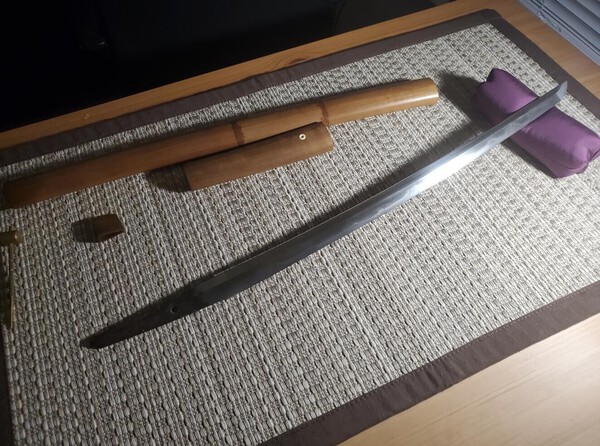
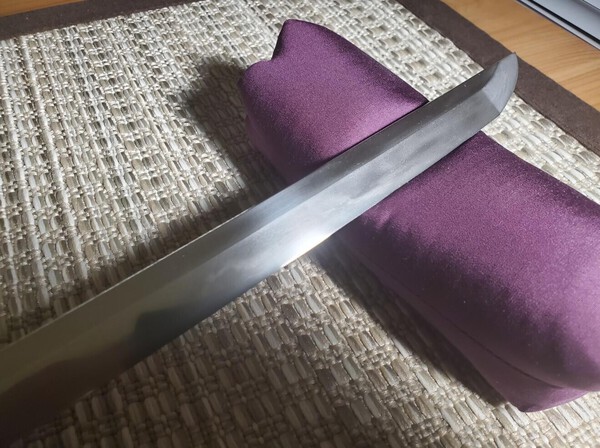
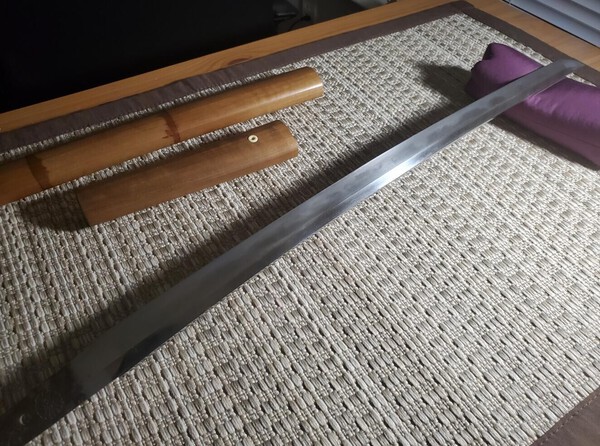

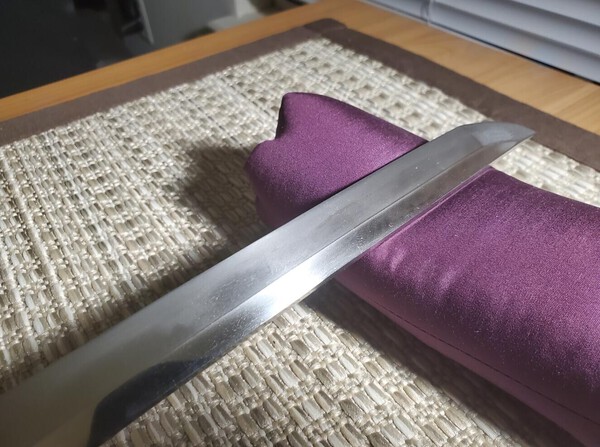
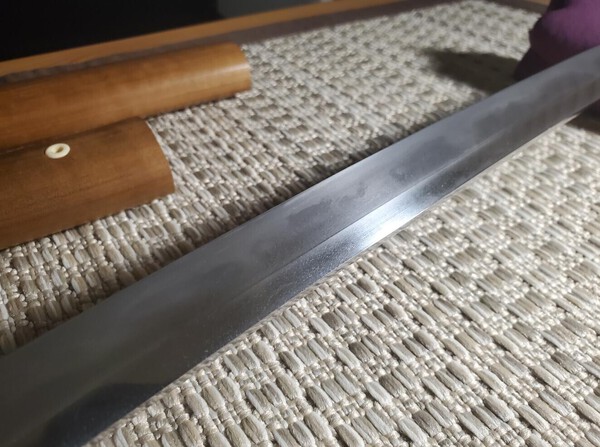
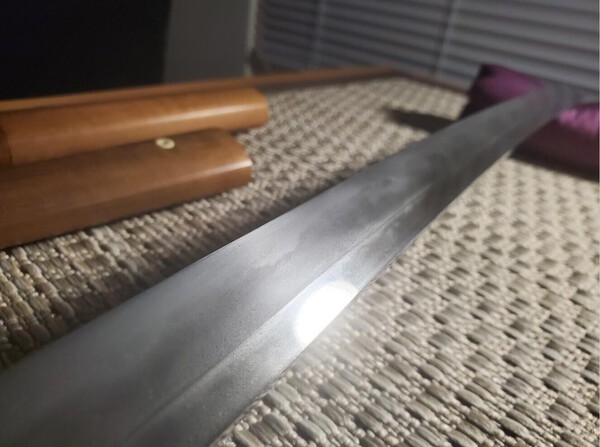
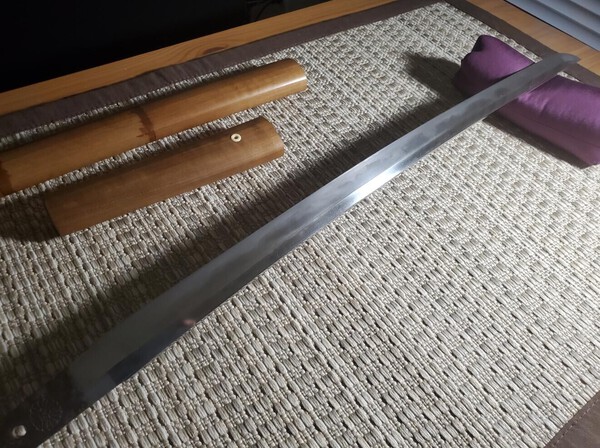
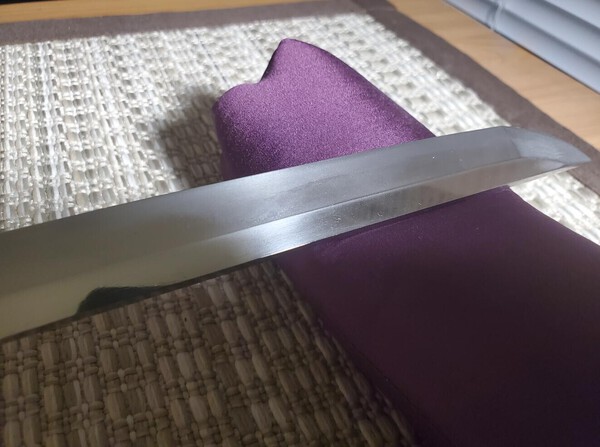
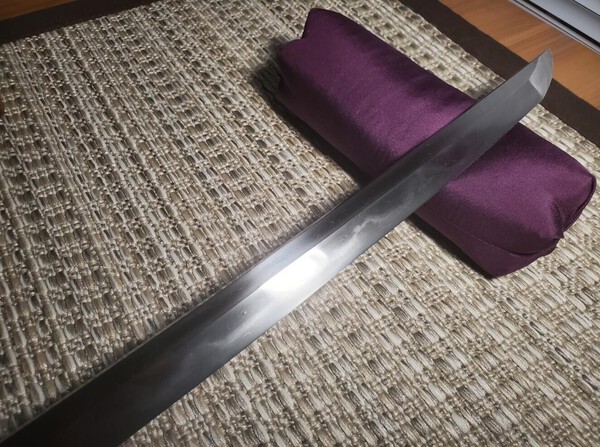
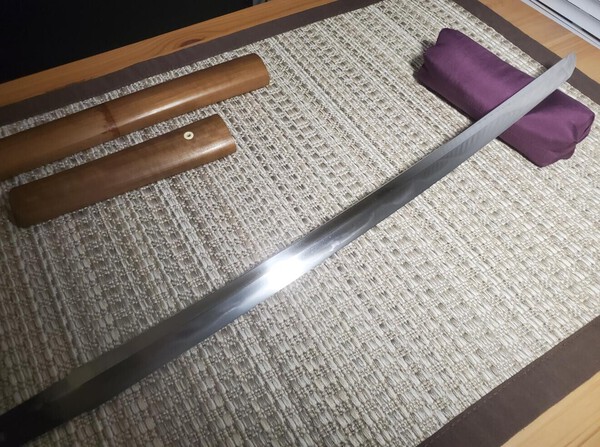
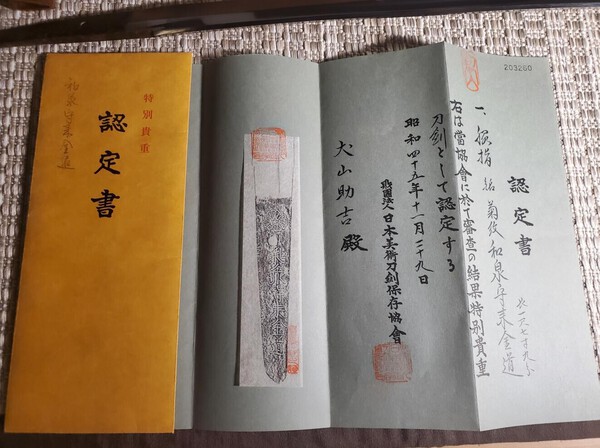
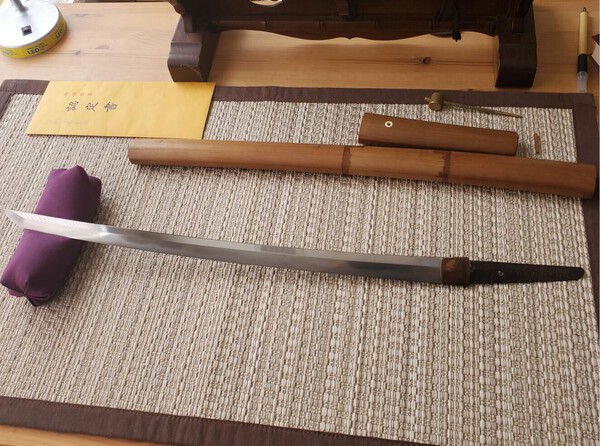
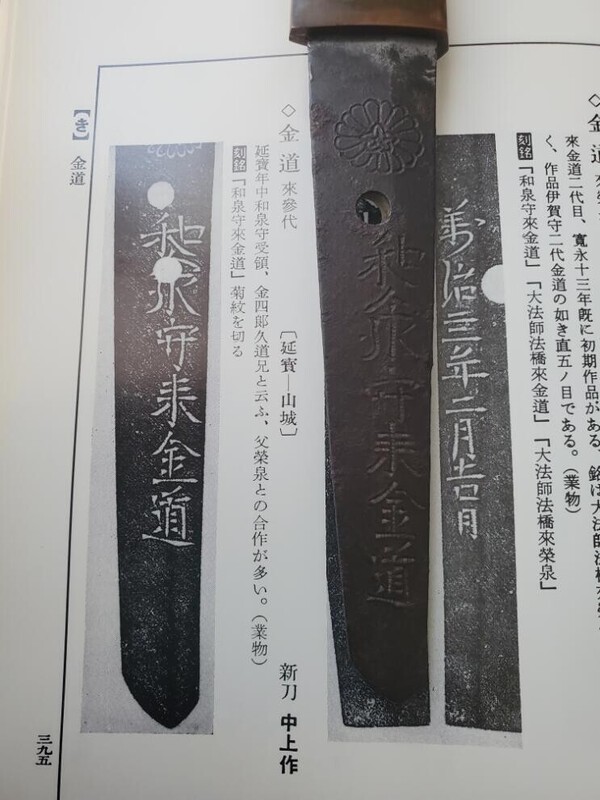
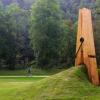
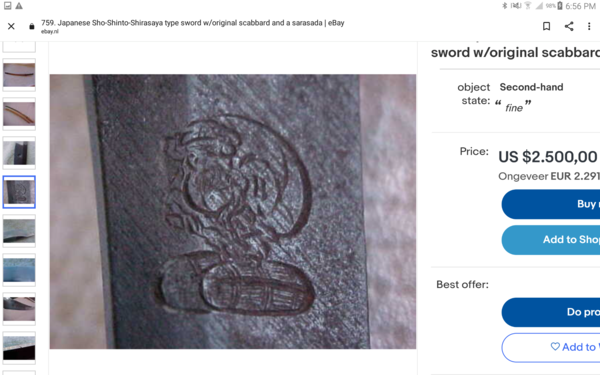
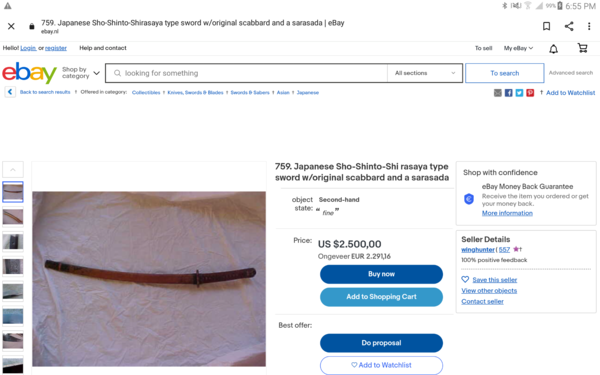
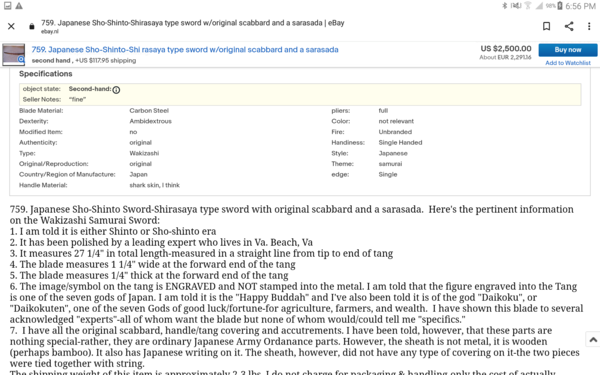





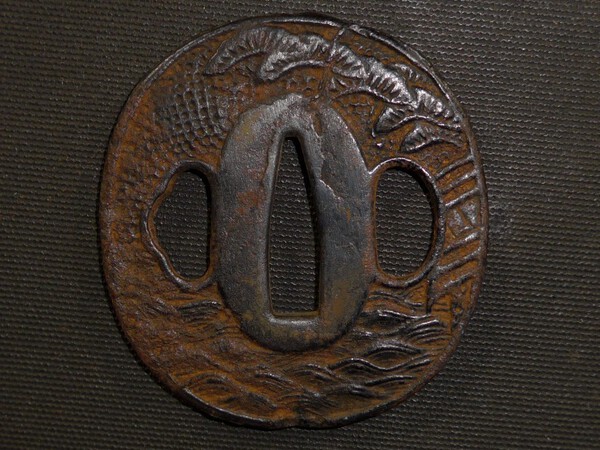
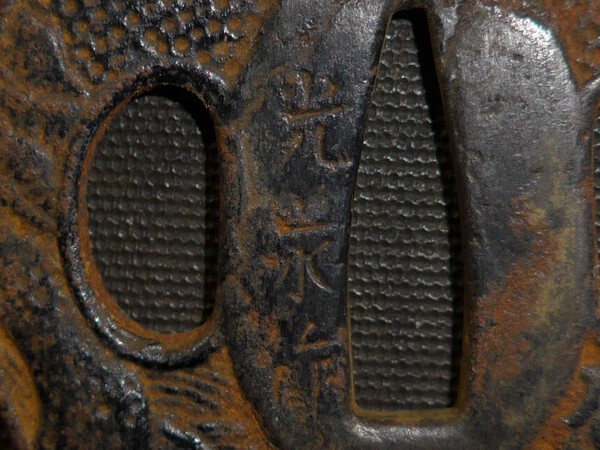








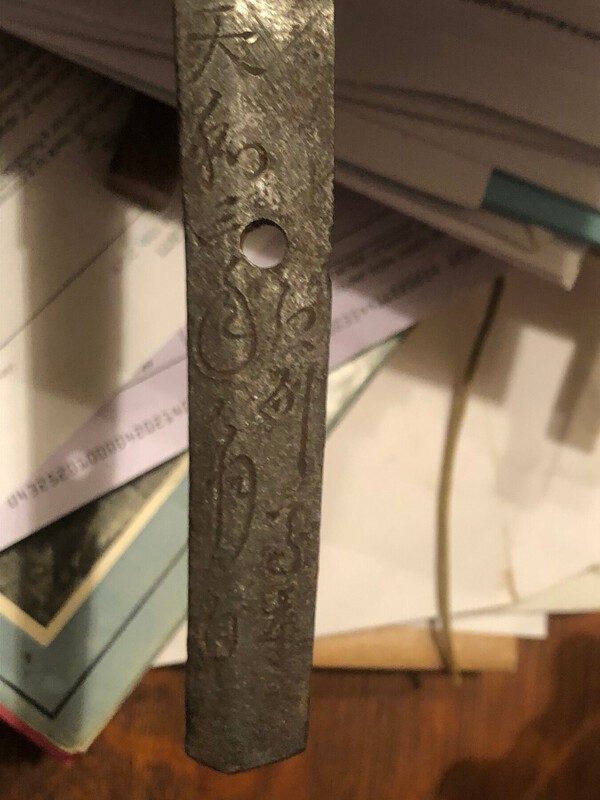







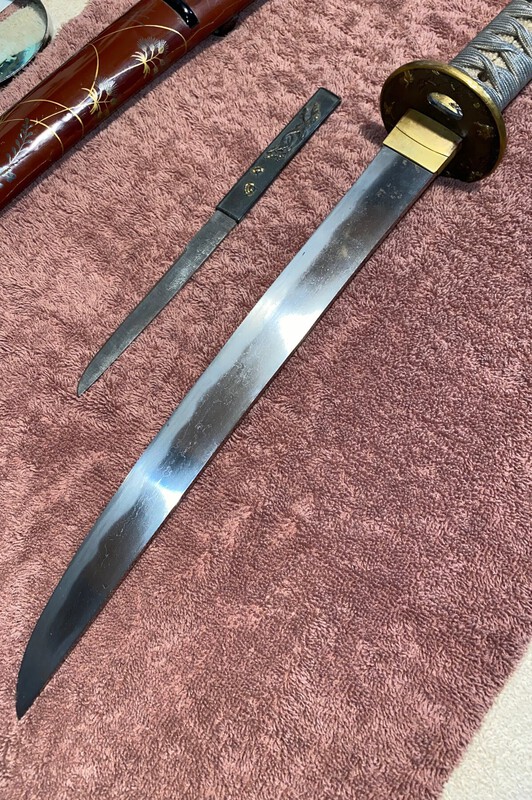


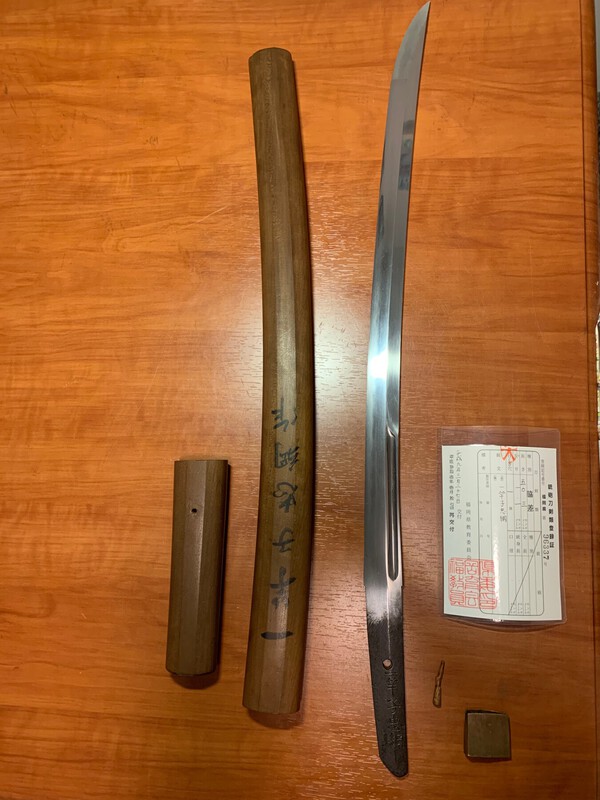


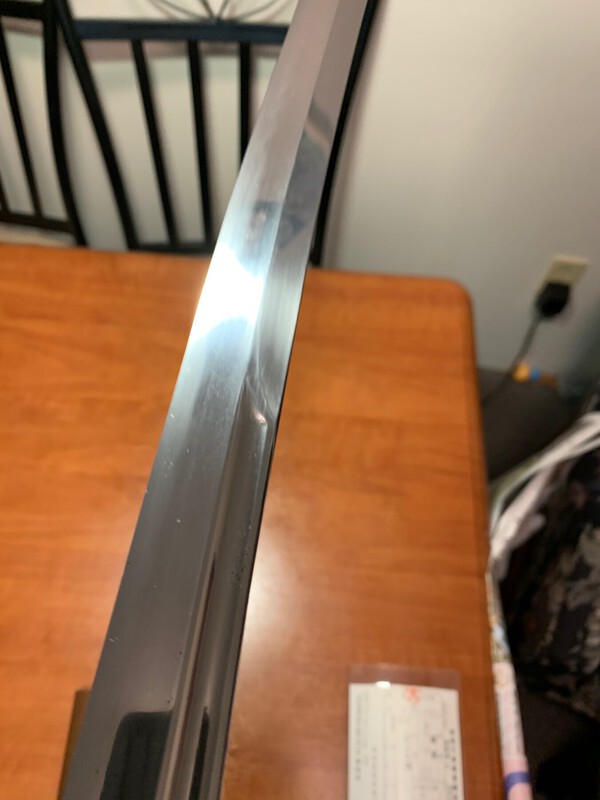


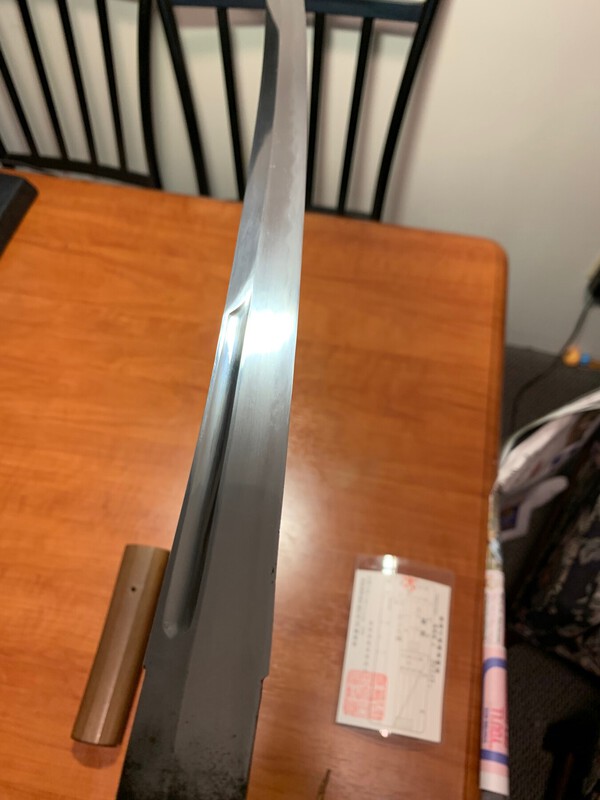




.thumb.jpeg.322aea5d00e154bdb42501c8b9f204bb.jpeg)
.thumb.jpeg.0ba9c0f5e7bced1cbe3b8bb4b401fe2c.jpeg)
.jpeg.0bd9734757ea40194725341242bac8f9.jpeg)
.thumb.jpeg.2a35663c236bafe8040b28c696455080.jpeg)
.thumb.jpeg.f3ba6a27b33361c1f5c30ce823537e1a.jpeg)
.thumb.jpeg.16b112426c669381a8104872e780eb9f.jpeg)
.thumb.jpeg.2213398b3b426f511a19611816a64610.jpeg)
.thumb.jpeg.b9860a0baa413d6ae7c422f24e321ab2.jpeg)
.thumb.jpeg.c2eea7b3f2cbbf31f9923dce6ee9657e.jpeg)
.thumb.jpeg.d4e62115d6229bfe14e6f1c6dd7e8c0f.jpeg)



